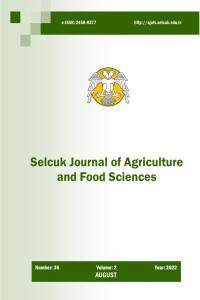Öz
In this study, two herbicides (Isoxaflutole 225 g/l + Thiencarbazone-Methyl 90 g/l + Cyrosulfamide 150 g/l and Dimethenamid-P 280 g/l + Terbuthylazine 250 g/l), which are commonly used pre-emergence period against weeds that cause problems in corn planting areas were investigated. The experiments were carried out under field conditions in order to investigate the effect of registered dose of the herbicides to the weeds and corn yield components at the Konya province in 2018 – 2019 years. Herbicides Isoxaflutole 90 g/l + Thiencarbazone methyl 150 g/l + Cyprosulfamide and 280 g/l Dimethenamide-p + 250 g/l Terbuthylazinewere tested in the pre-emergence period of the corn plant at doses of 35 ml/da and 300 ml/da, respectively. As a result of the experiments, Isoxaflutole 90 g/l + Thiencarbazone methyl 150 g/l + Cyprosulfamide were determined as the most effective herbicide to control weeds and increase corn yield components when it was applied during pre-emergence period. The effectiveness of herbicides was determined according to the biomass of weeds and their number in m2. In addition, in both years, A. retroflexus was determined as the most intense species with 16.83 plants/m2 and 32.97 plants/m2 ratios respectively, in the experimental areas. Considering the corn stem diameter, cob length, corn stem length, corn stem dry and fresh weight, dry and fresh cob weight, thousand-grain weight and yield per decare in both years, it was determined that the active substances used increased in yield 2 to 3 times compared to the weed control plots.
Anahtar Kelimeler
Ayrıntılar
| Birincil Dil | İngilizce |
|---|---|
| Konular | Bitki Bilimi |
| Bölüm | Araştırma Makalesi |
| Yazarlar | |
| Yayımlanma Tarihi | 30 Aralık 2022 |
| Gönderilme Tarihi | 25 Kasım 2022 |
| Yayımlandığı Sayı | Yıl 2022 Cilt: 36 Sayı: 4 |
Kaynak Göster
Selcuk Journal of Agriculture and Food Sciences Creative Commons Atıf-GayriTicari 4.0 Uluslararası Lisansı (CC BY NC) ile lisanslanmıştır.

